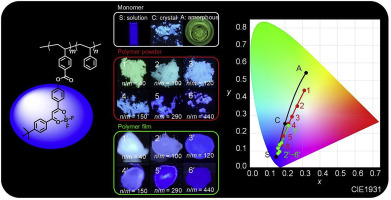Dyes and Pigments ( IF 4.5 ) Pub Date : 2020-02-15 , DOI: 10.1016/j.dyepig.2020.108283 Katsuya Shimizu , Arisa Okuma , Shiho Katsumi , Fuyuki Ito , Seiya Kobatake

|
Random copolymers (poly(ABSt-co-St)) consisting of Avobenzone-BF2 complex monomer (ABSt) and styrene (St) were synthesized and used for emission color tuning including white-like emission in the solid state using St units as a spacer. The emission color of ABSt in the resulting copolymers changed from green to blue via bluish-white by changing the content of St. The fluorescence quantum yields of the polymers in the solid state were relatively high (Φf = 0.30–0.51) independent of the composition contents. The polymers have two main emission bands around 440 and 540 nm, which were derived from the emission of single-molecule and amorphous aggregation, respectively. The fluorescence color changed according to a change in the ratio of the fluorescence intensity at 440 and 540 nm (F440/F540). The absorption and fluorescence properties of the polymers in tetrahydrofuran were independent of the composition ratio of ABSt and St, which indicates no intermolecular interaction between Avobenzone-BF2 (AB) fluorophores in the intra-polymer chain. The emission color of all polymers in the solution was blue and the fluorescence spectra were the same as that of ABSt in the solution. Thus, emission color changes observed in the solid state were mainly derived from the intermolecular interaction between AB fluorophores in inter-polymer chains because the polymers intertwined each other in the solid state. When the polymers in the solid state were annealed, F440/F540 increased and all of the fluorescence spectra became similar to that of monomer emission according to the arrangement change of the polymer chain. It is concluded that emission color changes of the polymers are mainly derived from intermolecular interaction between AB fluorophores in the inter-polymer chains. We have demonstrated that poly(ABSt-co-St) forms excellent homogeneous fluorescence polymer films. In contrast, the mixture of methoxy AB (ABOMe) and poly(St) undergoes crystallization even in the low content of ABOMe in poly(St).
中文翻译:

侧链含二氟硼阿伏苯宗配合物的聚苯乙烯的合成及多色发射性能
合成了由Avobenzone-BF 2络合物单体(ABSt)和苯乙烯(St )组成的无规共聚物(聚(ABSt- co -St)),并使用St单元作为固体,用于发射颜色调整,包括固态的白色样发射。垫片。在所得到的共聚物通过在固体状态下改变所述聚合物的圣的荧光量子产率的含量从绿色经由蓝白色变成蓝色ABST的发光颜色相对较高(Φ ˚F = 0.30–0.51),与成分含量无关。聚合物在440和540 nm附近有两个主要的发射带,分别来自单分子和无定形聚集体的发射。荧光颜色根据440和540 nm(F 440 / F 540)处的荧光强度之比的变化而变化。聚合物在四氢呋喃中的吸收和荧光性质与ABSt和St的组成比无关,这表明Avobenzone-BF 2之间没有分子间相互作用聚合物内链中的(AB)荧光团。溶液中所有聚合物的发射颜色为蓝色,荧光光谱与溶液中的ABSt相同。因此,在固态下观察到的发射颜色变化主要来自于在聚合物间链中的AB荧光团之间的分子间相互作用,因为聚合物在固态下相互缠绕。当固态聚合物退火时,F 440 / F 540随着聚合物链排列的改变,所有的荧光光谱增加,所有的荧光光谱变得类似于单体发射的荧光光谱。得出的结论是,聚合物的发射颜色变化主要源自聚合物链中AB荧光团之间的分子间相互作用。我们已经证明聚(ABSt- co- St)形成了优异的均质荧光聚合物膜。相反,即使聚(St)中的ABOMe含量低,甲氧基AB(ABOMe)和聚(St)的混合物也会发生结晶。



























 京公网安备 11010802027423号
京公网安备 11010802027423号